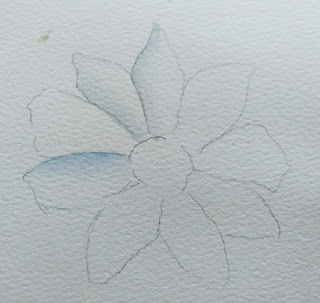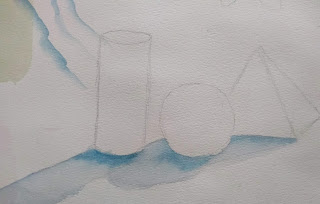CAST SHADOWS AND FORM SHADOWS
FORM SHADOWS are the ones on the object itself. They help define the shape/form of the object, making it look more 3-dimensional. I'll discuss those in another blog..
CAST SHADOWS are the shadow that light casts from one object or surface to another. There are several good reasons to pay close attention to the shadows in your painting. Here are a few.
1. Cast shadows set an object on a surface, so it doesn't look like it is "floating." Like a tree on the ground or a bowl on a table.
2. Use them to create more interest in shape and color in your painting. Think of a bicycle wheel with interesting cast shadows.
3. Use them to create mood, time of day, or a feeling of place.
4. Cast shadows can separate the objects and give them a more realistic appearance. Think of a white daisy. Each petal is white, so how can you see where they separate? It's because some of the petals cast a small shadow on the ones below them, creating a darker area that separates the petals.

5. Cast shadows can connect objects that are seemingly separate.

Here are some general rules about cast shadows.
Use the picture below for 1-5
1. Shadow touches the object when set on a surface, like a tree in the ground, bowl on a table.
2. Objects can cast a shadow on surfaces it does not touch: a cloud casting a shadow on the ground; shadow of a flower on a leaf. In the picture below, some of the orange pepper casts a shadow on the lower left of the green one.
3. Shadow is darkest where the two surfaces meet, then gets lighter and softer edged the further it gets from the object casting the shadow.
4. Shadow is "cooler than the color it is cast on. (note the general grayish tone)
5. Shadow is basically a distorted shape of the object.
Use the picture below for 6-9
6. Shadow often gets some color of the object refelcted in it, especially if the surface is shiny white.
Note the orange reflected into the shadow beneath the orange pepper.
7. Some of the color of the pepper on the left is reflected in the green pepper.
8. Length of the shadow depends on the angle of the light. Note in the photo above how much longer the shadows are than the picture below. The one above was taken about 6:00 p.m. in the sun. The one below was taken indoors with light above it.
At noon, shadow is very short; at 9 a.m. and 3 p.m. shadow is about the same size as the object. evening and early morning sun cast very long shadows .
9. Likewise, the DIRECTION of shadow depends on the position of the light.
10. Indoor light generally casts a softer shadow than direct sun.
11. Shadows of transparent objects will have some paler places where light shines through.
12. Cast shadows generally follow the contour of the object it is cast upon. If a tree shadow goes over a rocky path, it will take on bumps; it will follow the lay of the land, like the slant of a hill. In this picture, the light is on the right. The tree shadow is interrupted, but continues up the side of the building, then onto the roof at the angle of the roof.
WAYS TO CREATE SHADOWS
The first, most common way, is to paint the surface first, in this case, a blue table. Then, using a darker, grayer version of the same hue, paint in the shadow. I like to paint wet into wet; wetting the shadow area with water, then dropping in the paint where I want it to be darkest, then allowing it to spread and lighten as it moves away from the block.
The second, common way is to paint the shadow FIRST. In this one I used cerulean with a bit of burnt sienna in it to gray a little. After the shadow was dry, I GLAZED ovr the table with cerulean (blue).
Still darkening the area just beneath the box.
To paint the shadow of these, I first mixed a gray from French ultramarine and burnt sienna. This is a very common combination that you can turn brown with the addition of more burnt sienna, or cooler with more blue.
I wet the shadow, then dropped in the gray mix at the base of the peppers, and spread the color gently from there. I wanted it to be softer and more muted by the time it reached the end of the shadow.
While wet, I dropped some orange into the shadow of the orange pepper; a little dark green into the shadow of the green one.
Below are some photos of the same peppers on a blue surface so you can see how the color affects the shadow.
.

On the one below, note that beneath the right side of the orange pepper, the shadow is quite light right by the base of the pepper. This is because it is receiving some reflected light from a surface outside the picture area.
In the one below note the orange reflection in the green pepper. Also note how purple the reflection under the orange one looks. This is due to the visual blend of red in the orange and blue of the surface.
How can you tell how dark to make your shadow? Use your camera to temporarily turn your picture to black and white, as the one below. You may find it's not as dark as you think.
Blue surface
White surface
ONE FINAL TIP:
Some artists, to avoid confusion, draw a little tiny sun on the outer part of their picture (or on the tape) to remind them of where the light source is coming from. It's important to be consistent in the shadow direction and relative length.














No comments:
Post a Comment